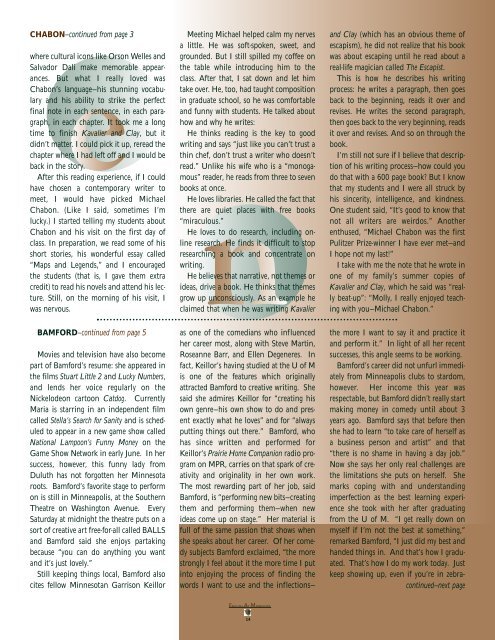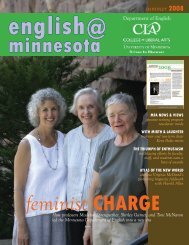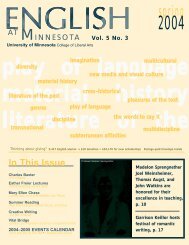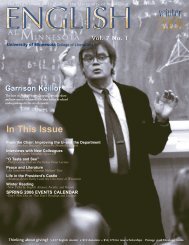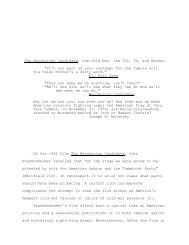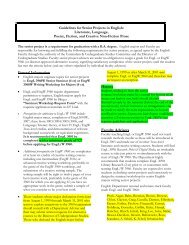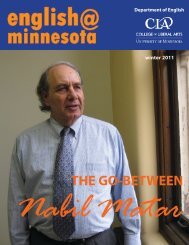fall M - Department of English - University of Minnesota
fall M - Department of English - University of Minnesota
fall M - Department of English - University of Minnesota
Create successful ePaper yourself
Turn your PDF publications into a flip-book with our unique Google optimized e-Paper software.
CHABON—continued from page 3<br />
where cultural icons like Orson Welles and<br />
Salvador Dali make memorable appearances.<br />
But what I really loved was<br />
Chabon’s language—his stunning vocabulary<br />
and his ability to strike the perfect<br />
final note in each sentence, in each paragraph,<br />
in each chapter. It took me a long<br />
time to finish Kavalier and Clay, but it<br />
didn’t matter. I could pick it up, reread the<br />
chapter where I had left <strong>of</strong>f and I would be<br />
back in the story.<br />
After this reading experience, if I could<br />
have chosen a contemporary writer to<br />
meet, I would have picked Michael<br />
Chabon. (Like I said, sometimes I’m<br />
lucky.) I started telling my students about<br />
Chabon and his visit on the first day <strong>of</strong><br />
class. In preparation, we read some <strong>of</strong> his<br />
short stories, his wonderful essay called<br />
“Maps and Legends,” and I encouraged<br />
the students (that is, I gave them extra<br />
credit) to read his novels and attend his lecture.<br />
Still, on the morning <strong>of</strong> his visit, I<br />
was nervous.<br />
Meeting Michael helped calm my nerves<br />
a little. He was s<strong>of</strong>t-spoken, sweet, and<br />
grounded. But I still spilled my c<strong>of</strong>fee on<br />
the table while introducing him to the<br />
class. After that, I sat down and let him<br />
take over. He, too, had taught composition<br />
in graduate school, so he was comfortable<br />
and funny with students. He talked about<br />
how and why he writes:<br />
He thinks reading is the key to good<br />
writing and says “just like you can’t trust a<br />
thin chef, don’t trust a writer who doesn’t<br />
read.” Unlike his wife who is a “monogamous”<br />
reader, he reads from three to seven<br />
books at once.<br />
He loves libraries. He called the fact that<br />
there are quiet places with free books<br />
“miraculous.”<br />
He loves to do research, including online<br />
research. He finds it difficult to stop<br />
researching a book and concentrate on<br />
writing.<br />
He believes that narrative, not themes or<br />
ideas, drive a book. He thinks that themes<br />
grow up unconsciously. As an example he<br />
claimed that when he was writing Kavalier<br />
and Clay (which has an obvious theme <strong>of</strong><br />
escapism), he did not realize that his book<br />
was about escaping until he read about a<br />
real-life magician called The Escapist.<br />
This is how he describes his writing<br />
process: he writes a paragraph, then goes<br />
back to the beginning, reads it over and<br />
revises. He writes the second paragraph,<br />
then goes back to the very beginning, reads<br />
it over and revises. And so on through the<br />
book.<br />
I’m still not sure if I believe that description<br />
<strong>of</strong> his writing process—how could you<br />
do that with a 600 page book But I know<br />
that my students and I were all struck by<br />
his sincerity, intelligence, and kindness.<br />
One student said, “It’s good to know that<br />
not all writers are weirdos.” Another<br />
enthused, “Michael Chabon was the first<br />
Pulitzer Prize-winner I have ever met—and<br />
I hope not my last!”<br />
I take with me the note that he wrote in<br />
one <strong>of</strong> my family’s summer copies <strong>of</strong><br />
Kavalier and Clay, which he said was “really<br />
beat-up”: “Molly, I really enjoyed teaching<br />
with you—Michael Chabon.”<br />
BAMFORD—continued from page 5<br />
Movies and television have also become<br />
part <strong>of</strong> Bamford’s resume: she appeared in<br />
the films Stuart Little 2 and Lucky Numbers,<br />
and lends her voice regularly on the<br />
Nickelodeon cartoon Catdog. Currently<br />
Maria is starring in an independent film<br />
called Stella’s Search for Sanity and is scheduled<br />
to appear in a new game show called<br />
National Lampoon’s Funny Money on the<br />
Game Show Network in early June. In her<br />
success, however, this funny lady from<br />
Duluth has not forgotten her <strong>Minnesota</strong><br />
roots. Bamford’s favorite stage to perform<br />
on is still in Minneapolis, at the Southern<br />
Theatre on Washington Avenue. Every<br />
Saturday at midnight the theatre puts on a<br />
sort <strong>of</strong> creative art free-for-all called BALLS<br />
and Bamford said she enjoys partaking<br />
because “you can do anything you want<br />
and it’s just lovely.”<br />
Still keeping things local, Bamford also<br />
cites fellow <strong>Minnesota</strong>n Garrison Keillor<br />
as one <strong>of</strong> the comedians who influenced<br />
her career most, along with Steve Martin,<br />
Roseanne Barr, and Ellen Degeneres. In<br />
fact, Keillor’s having studied at the U <strong>of</strong> M<br />
is one <strong>of</strong> the features which originally<br />
attracted Bamford to creative writing. She<br />
said she admires Keillor for “creating his<br />
own genre—his own show to do and present<br />
exactly what he loves” and for “always<br />
putting things out there.” Bamford, who<br />
has since written and performed for<br />
Keillor’s Prairie Home Companion radio program<br />
on MPR, carries on that spark <strong>of</strong> creativity<br />
and originality in her own work.<br />
The most rewarding part <strong>of</strong> her job, said<br />
Bamford, is “performing new bits—creating<br />
them and performing them—when new<br />
ideas come up on stage.” Her material is<br />
full <strong>of</strong> the same passion that shows when<br />
she speaks about her career. Of her comedy<br />
subjects Bamford exclaimed, “the more<br />
strongly I feel about it the more time I put<br />
into enjoying the process <strong>of</strong> finding the<br />
words I want to use and the inflections—<br />
the more I want to say it and practice it<br />
and perform it.” In light <strong>of</strong> all her recent<br />
successes, this angle seems to be working.<br />
Bamford’s career did not unfurl immediately<br />
from Minneapolis clubs to stardom,<br />
however. Her income this year was<br />
respectable, but Bamford didn’t really start<br />
making money in comedy until about 3<br />
years ago. Bamford says that before then<br />
she had to learn “to take care <strong>of</strong> herself as<br />
a business person and artist” and that<br />
“there is no shame in having a day job.”<br />
Now she says her only real challenges are<br />
the limitations she puts on herself. She<br />
marks coping with and understanding<br />
imperfection as the best learning experience<br />
she took with her after graduating<br />
from the U <strong>of</strong> M. “I get really down on<br />
myself if I’m not the best at something,”<br />
remarked Bamford, “I just did my best and<br />
handed things in. And that’s how I graduated.<br />
That’s how I do my work today. Just<br />
keep showing up, even if you’re in zebracontinued—next<br />
page<br />
ENGLISH AT MINNESOTA<br />
14


